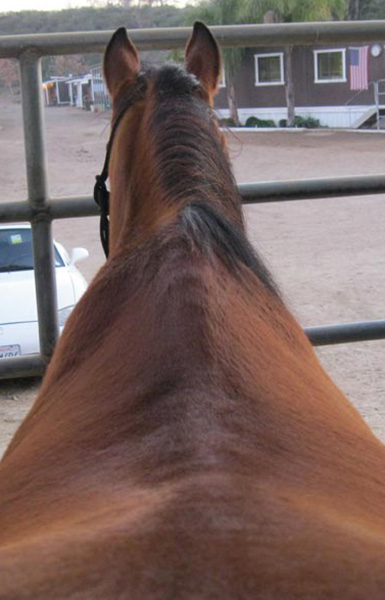It is important to not only make sure that you are using the right equipment on your horse but, that it fits the horse and you are using it properly. I have seen many saddles that do not fit the horse that they are on. It is important to talk to the tack dealer you are buying from to make sure your equipment is all in proper order. I am going to cover some of the most common errors I see and how to know that you may have a problem.

It is important to understand that not every saddle fits every horse and that not every saddle fits every rider. It is critical to get a saddle that fit both you AND your horse.
The following is a list of red flags that may indicate your saddle doesn't fit your horse right.
• Dry Patches after riding

-Notice how along the spine of this horse it is still dry. That means that the saddle is not properly distributing the weight. You should see an even sweat pattern when you remove your saddle.
• Scuff or rub marks
• White hairs
• Saddle touching at withers



• Cold backed

It is important to understand that not every saddle fits every horse and that not every saddle fits every rider. It is critical to get a saddle that fit both you AND your horse.
The following is a list of red flags that may indicate your saddle doesn't fit your horse right.
• Dry Patches after riding
-Notice how along the spine of this horse it is still dry. That means that the saddle is not properly distributing the weight. You should see an even sweat pattern when you remove your saddle.
• Scuff or rub marks
• White hairs
• Saddle touching at withers

• Cold backed
• Bucking or rearing
• Bolting
• Bolting
• Reluctance to go down or up hill
• Training Issues
• Training Issues
• Saddle rocking
• Sore back
• Sore back
• Tail swishing
• Ears back when saddling
• Girthy
• Dislikes saddle being put on

• Slow to Relax
• Behavioral issues
• Sensitivity
• Head tossing
• Swelling
• Short choppy stride
• High head carriage
• Reluctance to move
• Difficult lead changes
• Unbalanced

• Ears back when saddling
• Girthy
• Dislikes saddle being put on

• Slow to Relax
• Behavioral issues
• Sensitivity
• Head tossing
• Swelling
• Short choppy stride
• High head carriage
• Reluctance to move
• Difficult lead changes
• Unbalanced
• Saddle slipping

• Rider having problems staying in position
• Saddle sitting down hill in front, up hill in front or off to one side


How to measure a saddle. In order to buy a proper fitting saddle it is important to know how to measure it correctly. Narrow horses need saddles with a smaller gullet and wider horses need larger gullet sizes.

This tree size has a higher pitch or angle to the bars.
It’s for the horse with a more defined wither. (1/2 Arab, Appendix, Thoroughbred, etc).
 Full-QH: Full Quarter Horse or FQHB can be referred to as Wide (usually 7” gullet).
Full-QH: Full Quarter Horse or FQHB can be referred to as Wide (usually 7” gullet). The angle is flatter compared to the Semi-QH tree.
This is for horses with a broad shoulder.
They’re considered mutton withered or a less pronounced wither. (Quarter Horse, Paint, etc)
Notice how the horse in the second picture has a much wider withers and thicker.
The following is an informational video on saddle fit.
From the author:
Saddle fit is incredibly important. It comes down to finding a saddle that fits your horse and then finding one that fits you. All horses are different and you may have had a favorite saddle that you have used for years but if it doesn't fit your new horse its time to find another one. I know personally that having a saddle that fits your horse makes a huge difference.
Saddle fit is incredibly important. It comes down to finding a saddle that fits your horse and then finding one that fits you. All horses are different and you may have had a favorite saddle that you have used for years but if it doesn't fit your new horse its time to find another one. I know personally that having a saddle that fits your horse makes a huge difference.
Really Superb Blog..Visit our online store and purchase our Nero elastic girth. With dual elastic buckles and gel centre insert it's the ultimate in comfort for your performance horse.
ReplyDeleteElastic Girths